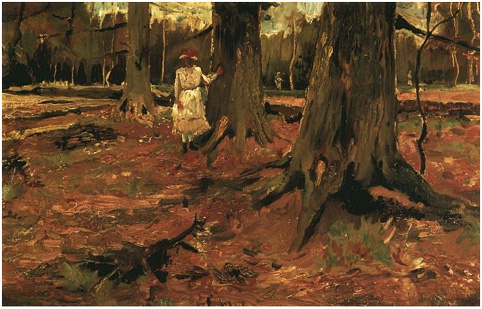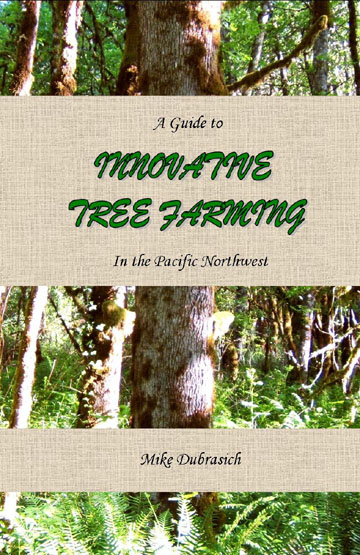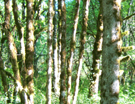Chapter 8: Tree Farm Stewardship
From A Guide to Innovative Tree Farming in the Pacific Northwest by Mike Dubrasich. 2005. Whirlwind Press. For a hard copy of the book ($10 - includes shipping) please contact W.I.S.E. [here].

Tree farming is an enjoyable, worthwhile, and honorable occupation. Those of us lucky enough, or determined enough, to be tree farmers are privileged to be able to do it. With that privilege comes the responsibility to be good stewards of the land.
Tree farm stewardship is using property to produce commodities while preserving the intrinsic productivity of the land. Tree farm practices should never abuse, erode, pollute, or otherwise render land, yours or your neighbor’s, unfit for agriculture. Good stewardship means protecting water and air quality, too. Fortunately, good stewardship and innovative tree farming go hand-in-hand.
Ownership of tree farms by individuals and families promotes good stewardship. Stewardship is a relationship between the landowner and the land. People develop deep psychological identifications with property. For landowners especially, our properties become part of our identities. Owners care for their lands as they care for themselves and their families. The landowner who harms his property harms himself, and generally loses his land. Public land, property that no individual can claim as a unique identity, receives notoriously bad stewardship.
Public policies aimed at achieving good land stewardship should promote private property ownership. It’s in the public’s interest to have a free market in land, without monopolies or government-owned agri-businesses. It’s in the public’s interest to prevent pollution and land degradation, and private individual ownership provides that stewardship function better than any other form of land ownership.
The exceptions to this rule might be parks, forests, and nature preserves. We need wild places, and privately-owned property is never truly wild. This is not to say that private property owners should never grow forests, but the luxury is beyond the means of most of us. Only public lands hold the possibility of growing real forests. Real forests are big; they are vast stretches of natural ecosystem. I hope that someday public agencies will learn how to be good stewards of parks, forests, and nature preserves.
Innovative and successful tree farmers form deep bonds with their properties. Tree farmers are there when the rising sun shafts through the trees, when the rains fall, when the breezes blow, when the flowers bloom, when the birds sing, and when the setting sun paints the sky. Tree farmers kneel to plant seedlings in acts of faith, and watch year after year as the trees fulfill their promise and grow toward the sky. Tree farmers are grown on tree farms, too. Of such stuff is great stewardship made.
Chapter 1: An Introduction to Innovative Tree Farming
From A Guide to Innovative Tree Farming in the Pacific Northwest by Mike Dubrasich. 2005. Whirlwind Press. For a hard copy of the book ($10 - includes shipping) please contact W.I.S.E. [here].

If you own rural property in the Pacific Northwest, then this book is for you. Tree farming is one of the best ways to use your property. It’s relatively easy, non-polluting, low maintenance, interesting, and it can be very profitable, too.
Tree farming is the art and science of growing, harvesting, and marketing large, woody plants. Trees are fascinating, lovely, noble, and enjoyable to grow. Tree farming is also a business, one that uses natural phenomena (plants, soil, rain, and sunshine) to produce commercial goods and materials. Most rural landowners grow trees on their property, and many of them make money harvesting sawlogs, Christmas trees, firewood, boughs, cones, or hundreds of other tree products. That’s tree farming. Many so-called “forests” in the Pacific Northwest are actually tree farms: plantations of trees grown to be commercially harvested. (Orchards and nurseries are also types of tree farms, but they are outside the scope of this book.)
Tree Farms Are Not Forests
Warning: this essay shifts a paradigm. Please remain seated while reading, to avoid injuries from fainting.
Ready? Here it is: tree farms are not forests and forests are not tree farms. The Old Paradigm holds that they are the same thing. The New Paradigm, presented herein, says they are completely and utterly different land uses. Well, maybe not utterly. Tree farms and forests both have trees. Other than that, the differences are starkly obvious and fundamental. Understanding the differences will benefit you, whether you are pro-tree farms, pro-forests, or pro-both, like me.
How are tree farms and forests different? Let us count the ways. First, they are structurally different. By “structure” I mean the three- dimensional, above-ground lattice: the stems, branches and leaves that constitute the architectural framework.
On tree farm plantations the trees are all the same age, down to the week or day of planting. They are evenly spaced. As they grow, all the trees have similar heights, crown shapes, crown lengths, and stem diameters. Structure is homogeneous.
In forests the trees are never the same age. Even in so-called “even- aged” forests, stem recruitment actually lasts for many decades following stand replacement disturbance. In forests the trees are never evenly spaced. As differently aged and spaced trees grow, they diversify into unequal heights, crown shapes, crown lengths, and stem diameters. Structure in forests is heterogeneous horizontally and vertically.
Second, tree farms and forests are different biologically. Tree farm stands have only a few tree species, sometimes only one. Very few other plant species occur, especially under the dense canopies of fully- stocked plantations. Nor do many wildlife species find preferred habitat on tree farms, because of the structural and biological limitations.
